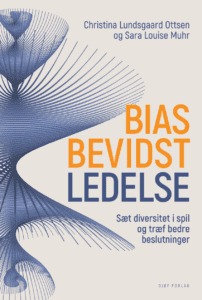
Cognitive psychologist Christina Lundsgaard Ottsen recently published the leadership book Bias-conscious leadership – Bring diversity into play and make better decisions. In this book, she and her co-writer, Professor Sara Louise Muhr, encourage all of us to work actively with diversity in management as a means to minimise bias.
The book flows with the current of new thinking in leadership research that focuses on shared leadership, distributed leadership, and processual leadership. In other words, it is about the more relational aspects of leadership rather than the classic trait theory that focuses on the leader’s good traits and behaviour.
One of the book’s basic premises is that good leadership is produced by the relationship between the surroundings and the culture in the organisation – such as colleagues, middle managers, and technological tools.
This means that, as a leader, you can’t just transfer a leadership style that worked in one organisation to another and achieve the same results. Instead, you can use bias-conscious leadership.
Bias-conscious leadership is about your understanding of the relationship dynamics that influence you and your decisions as a leader – and how they in turn influence the team and the organisation. New people and new systems require a new kind of leadership.
As a leader, you can create consciousness of bias by working purposefully with the different intelligences in or around the organisation:
When you are aware of leveraging these intelligences and use them wisely, you can minimise blind spots, strengthen critical thinking and facilitate the use of knowledge and experiences from the entire organisation.
Artificial intelligence is an important data-collection source that can counteract bias. But artificial intelligence is also inherently problematic when it comes to bias if you, as a leader, are unaware of the pitfalls associated with it. The process of producing, collecting and processing data is always influenced by people and their biases, for instance.
This means that you must always remain sceptical of algorithmic bias. You need to ask yourself how data were collected, who collected them and who processed them.
Cultural intelligence is about your ability to leverage all the cultural differences within an organisation. Behavioural design can be of great help in this regard.
Behavioural design is basically about designing surroundings to facilitate habit changes, encouraging us to act more consistently with the way we want to act, while acknowledging that we never act fully rationally. Behavioural design lets you influence how employees and leaders approach everyday bias.
This is important: if you don’t invite diversity in your team or organisation and make sure that employees are exposed to different perspectives at work, you risk ending up with poor solutions influenced by bias.
Being constantly aware of bias during busy workdays requires a lot of mental effort, however. Behavioural design can help you automate a lot of processes to minimise or completely eliminate certain biases.
Collective intelligence is the entire amount of knowledge and experience available to the organisation’s employees. This collective intelligence is often not activated, however, since great parts of the organisation’s knowledge never reach the managerial decision-making space. It remains unheard and invisible, and management will miss out on a great opportunity to bring diversity into play.
The hierarchical structure of organisations and their power hierarchies create barriers for knowledge sharing. But as a leader with an inclusive mindset, you can move past the downsides of the hierarchy and break those barriers.
This means that you must both create an inclusive environment for the employees and use a leadership style that encourages them to share their knowledge and views without fear of repercussions when communicating with you or other decision makers within the organisation.
It is your responsibility to make sure that the employees feel safe enough to express their opinions and participate in teamwork that encourages them to do so. This requires you to listen with both interest and empathy to what people say. Leaders who are unaware of their position of power risk losing their ability to see things from others’ perspectives or not attribute any importance to them.
Source: Bias-conscious leadership
Bias-conscious leadership ties together artificial, cultural, and collective intelligence. Bias-conscious leadership requires digital leadership, behavioural leadership, and inclusive leadership.
Digital leadership is necessary to collect enough data – and ensure that it is used properly. Behavioural leadership will help challenge everyday bias. And inclusive leadership builds the reflective practice necessary for efforts in the two other areas to succeed. These intelligences are interdependent.
In your effort to leverage these intelligences, you will develop your leadership and your ability to lead rationally. Bias consciousness will, by definition, make you a better leader. Good leaders are those who reflect and read situations.
The best-performing leaders in evaluations are those with high empathy scores. This means that good leaders have their antennae out and reflect on both their own and their colleagues’ practices.
Attaining bias consciousness is a process for a leader but getting started doesn’t have to be hard. You can start small and take one little step at a time. But you need both the energy and the courage to hold a mirror to both your own and your colleagues’ thinking and behaviour.
Source: Bias-conscious leadership

Christina Lundsgaard Ottsen is a Senior consultant in Mannaz and cognitive psychologist with a PhD in cross-cultural diversity. As a researcher, Christina worked with diversity in Scandinavia and the Middle East, and she went on to become an expert in inclusive leadership focusing on the psychological mechanisms behind cognitive bias.
 She facilitates decision-making processes and sustainable development in organisations through increased cultural awareness about teamwork. Since 2008, she has worked strategically with diversity and inclusive leadership to increase the quality of decision-making processes and strengthen sustainable development.
She facilitates decision-making processes and sustainable development in organisations through increased cultural awareness about teamwork. Since 2008, she has worked strategically with diversity and inclusive leadership to increase the quality of decision-making processes and strengthen sustainable development.
Christina is the author of the book “Biasbevidst ledelse – Sæt diversitet i spil og træf bedre beslutninger” (Bias-conscious leadership – Bring diversity into play, and make better decisions).
Contact Christina at cot@mannaz.com or +45 2682 8885